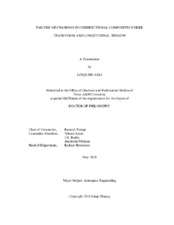| dc.description.abstract | This dissertation deals with analysis of failure mechanisms in unidirectional reinforced fiber composites under axial and transverse tensile loads. These two failure modes are fundamental in governing the performance of composite materials in most applications. In spite of many years of research in the mechanisms underlying these failure modes, gaps in their understanding have remained. This dissertation attempts to fill those gaps.
Two particular issues are addressed in the studies conducted here: 1) under transverse tension, what is the process by which fiber/matrix debond cracks link up to form transverse cracks, and 2) under longitudinal tension, how does a fracture plane form? In the study, related to transverse tension, plausible mechanisms for transverse crack formation are considered in two scenarios: Scenario 1 where a pre-existing single fiber/matrix debond crack kinks out into the matrix and induces fiber/matrix debonding at neighboring fibers, and Scenario 2 where multiple pre-existing debond cracks link up by the debond growth and crack kink-out process. A 2-D finite element model consisting of a circular region of matrix with a central fiber surrounded by six fibers in a hexagonal pattern is used for the local stress analysis. The region is embedded in a homogenized unidirectional composite of rectangular outer boundary. Energy release rates (ERRs) of interface cracks and kinked-out cracks are calculated under applied tension normal to fibers. Results show that Scenario 2 is more likely to lead to formation of a transverse crack than Scenario 1. The study related to longitudinal tension considers a broken fiber as the nucleation site for formation of a plane whose unstable growth leads to failure. To analyze the conditions for formation of this “critical fracture plane”, an axisymmetrical finite element model is constructed with the broken fiber at the center surrounded by intact fibers. Here, too, two scenarios are considered: one, where the broken fiber results from the manufacturing process, and two, where a fiber fails at a weak point under loading. In the first case, a matrix crack is found to initiate from the broken fiber end and grow normal to the fiber axis, while in the second case, a matrix crack kinks out of an assumed short fiber/matrix debond crack and grows out toward the neighboring fibers.
The studies conducted here provide valuable input into multiscale approaches that link the local failure to global response of composite structures. | en |


